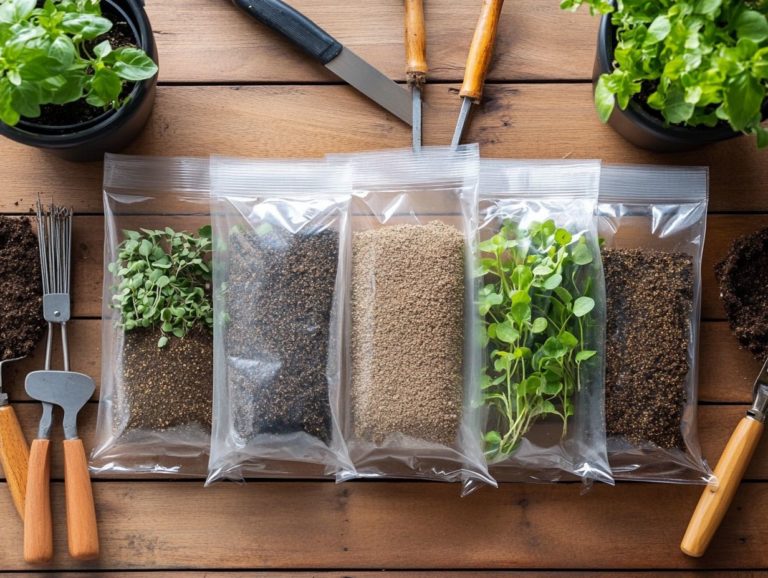Understanding the Soil Food Web in Cold Climates
The soil food web is a sophisticated network of living organisms that plays an essential role in maintaining soil health and fertility. In cold climates, this intricate web faces unique challenges, yet it remains indispensable for supporting plant growth, resilience, and effective weed suppression.
This article delves into the fundamental components of the Soil Food Web. It examines how cold weather influences its dynamics and offers practical techniques for enhancing its vitality, particularly through organic farming practices. By understanding and nurturing this ecosystem, including soil microorganisms and mycorrhizal fungi, you can minimize your reliance on chemical fertilizers and significantly boost your garden s productivity through enhanced soil biology.
Explore how to cultivate a thriving Soil Food Web, even in the chilliest conditions. Unlock the secrets to flourishing vegetation by implementing sustainable agriculture techniques.
Contents
- Key Takeaways:
- The Basics of the Soil Food Web
- Cold Climate Considerations
- Components of the Soil Food Web
- Improving the Soil Food Web in Cold Climates
- Benefits of a Healthy Soil Food Web in Cold Climates
- Frequently Asked Questions
- What is the Soil Food Web in Cold Climates?
- Why is Understanding the Soil Food Web Important in Cold Climates?
- What Challenges Does the Soil Food Web Face in Cold Climates?
- How Can I Improve the Soil Food Web in My Cold Climate Garden?
- What role do plants play in the soil food web of cold climates?
- Can I still have a thriving soil food web in my cold climate if I use synthetic fertilizers and pesticides?
Key Takeaways:
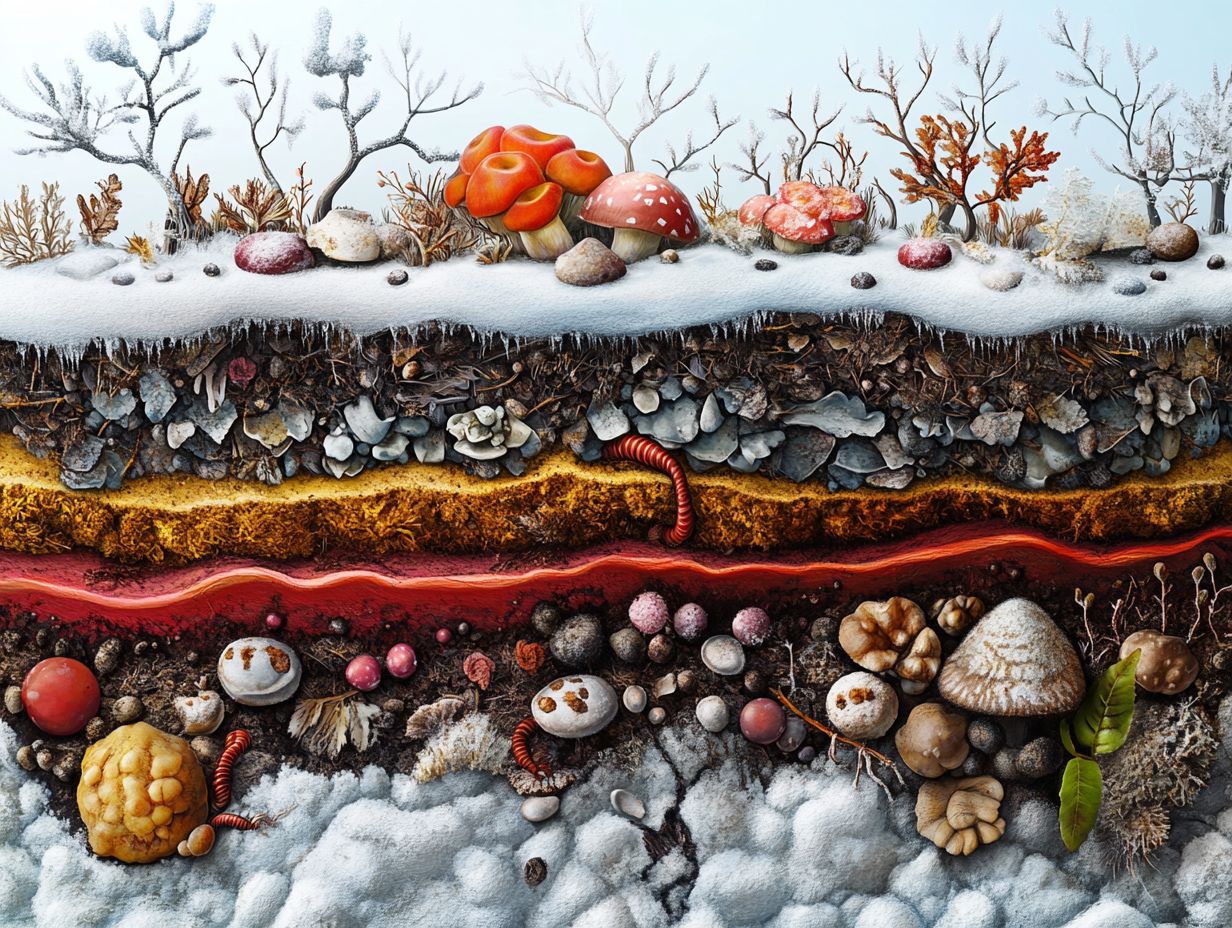
- In cold climates, the soil food web can be negatively impacted by harsh conditions, but there are ways to adapt and improve it.
- Microorganisms, plants, and animals all play important roles in the soil food web. Choosing cold-adapted plants can help maintain a healthy balance while enhancing soil nutrients.
- A healthy Soil Food Web in cold climates can lead to stronger and more resilient plant growth. This reduces the need for chemical fertilizers and supports effective crop resistance against pests and diseases.
The Basics of the Soil Food Web
The Soil Food Web is a sophisticated network of soil organisms that plays a vital role in soil regeneration, nutrient recycling, and the overall functionality of ecosystems. This network is particularly important in enhancing soil health.
It unveils the intricate relationships among various soil microorganisms, including bacteria, fungi, nematodes, and mycorrhizal fungi. All of these work together to enhance soil health and agricultural productivity, supporting the entire soil community.
Pioneered by Dr. Elaine Ingham, this concept underscores the significance of a thriving soil community in sustaining ecological balance and promoting plant vitality. By fostering such a community, you can reduce reliance on chemical inputs while simultaneously boosting crop resilience against pests and diseases.
What is the Soil Food Web?
The Soil Food Web is an intricate network of various soil organisms, including microorganisms, plants, and animals. All of these interact to sustain ecosystem functions and promote soil health.
This dynamic system is essential for nutrient recycling. Microorganisms break down organic matter to release the vital nutrients that your plants need for optimal growth. Healthy plants, in turn, return organic material to the soil. This creates a thriving environment for soil arthropods like nematodes and earthworms.
These tiny dwellers not only enhance soil structure but also create spaces that improve aeration and water retention. Together, this complex interplay among organisms does more than just support plant vitality; it boosts soil resilience, making your agricultural lands more productive and sustainable over time.
Why is it Important?
Understanding the significance of the Soil Food Web is essential for achieving soil regeneration, enhancing nutrient availability, and boosting agricultural productivity. It plays a pivotal role in nutrient recycling and maintaining robust soil ecosystems.
A vibrant Soil Food Web serves as a natural defense against pests and diseases. This allows you to reduce reliance on chemical interventions. Beneficial microorganisms and insects collaborate harmoniously to suppress harmful pathogens, enhancing resilience in your farming practices.
Healthy soil systems contribute to carbon sequestration, capturing atmospheric carbon dioxide and helping to mitigate the impacts of climate change while enhancing environmental benefits. These processes support soil conservation and promote sustainable farming practices that align with ecological principles.
Nurturing the Soil Food Web empowers you to create a vibrant ecosystem that benefits both your crops and the planet! Start implementing these techniques today for a thriving garden!
Cold Climate Considerations
In cold climates, you encounter distinct challenges and opportunities when it comes to nurturing a thriving Soil Food Web. The interactions among soil organisms like mycorrhizal fungi, protozoa, and various microorganisms are profoundly shaped by temperature and moisture levels. These factors play a crucial role in determining soil health and, ultimately, agricultural yields.
How Cold Weather Affects the Soil Food Web
Cold weather profoundly impacts the Soil Food Web by altering the activity and survival of various soil microorganisms. This can lead to challenges such as soil compaction and increased vulnerability to erosion, ultimately undermining soil health.
As temperatures drop, the activity levels of these microorganisms decrease. This results in reduced activity and a decline in vital nutrient cycling processes. Nutrient cycling is the process of reusing nutrients in different forms. This slowdown can hinder organic matter decomposition, which is essential for maintaining soil fertility. Changes in microbial populations disrupt the delicate balance between different species, further compromising nutrient availability.
These shifts can cause soil structure to deteriorate, making it more susceptible to compaction. Such disruptions not only hamper agricultural productivity but also threaten the overall resilience and health of the entire ecosystem. Understanding these interactions becomes crucial, especially in the context of climate variability and its influence on soil ecosystem functions.
Adapting to Cold Climates
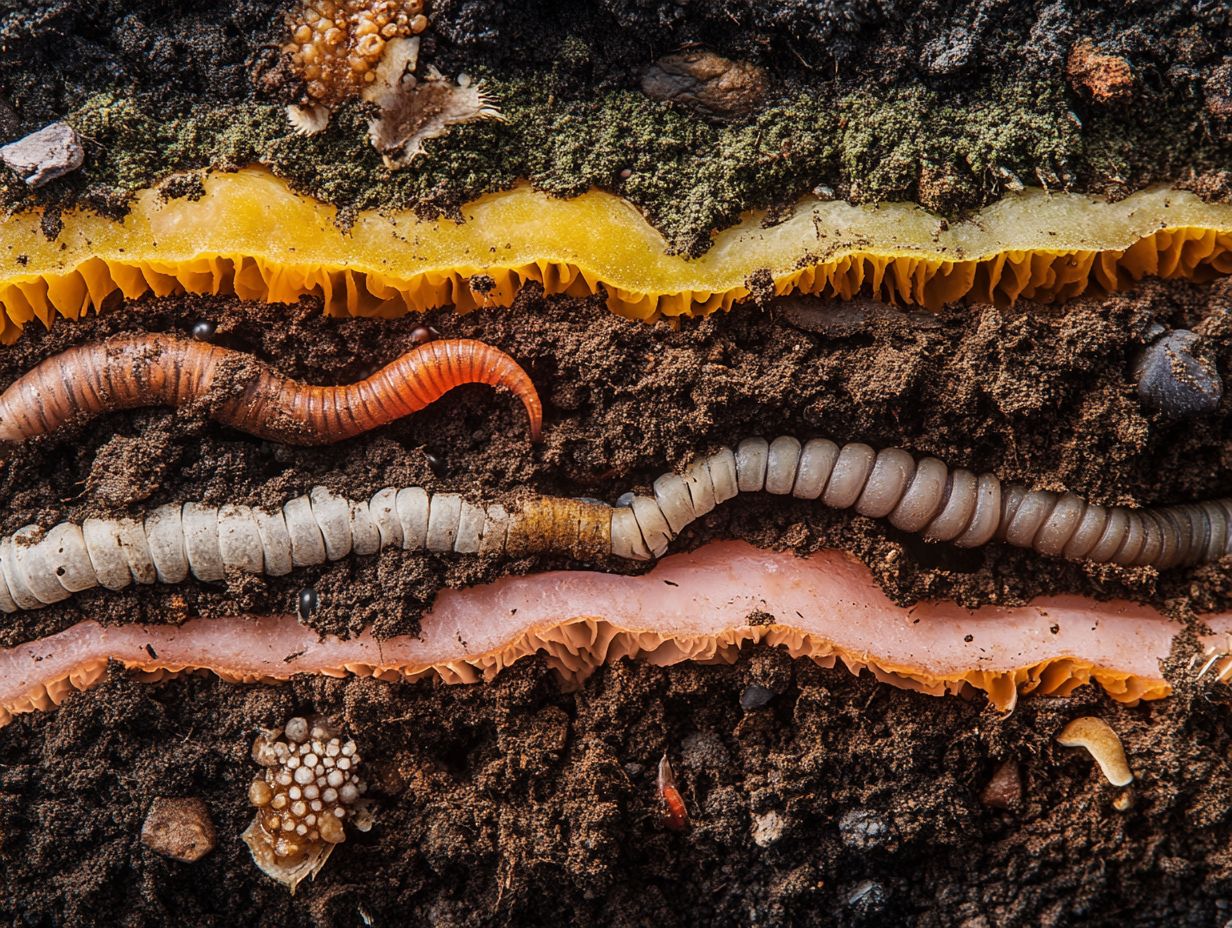
It’s essential to protect the vibrant life within the Soil Food Web! Adapting your farming practices to cold climates is crucial for preserving soil health and supporting effective soil management.
- Use soil amendments like compost.
- Embrace organic farming methods to enhance soil biology.
- Implement cover crops to minimize erosion and improve soil structure.
By introducing diverse planting systems, you create a vibrant ecosystem that naturally combats pests and diseases. Integrating organic inputs like compost and mulches, along with effective soil management practices, is another excellent way to provide essential nutrients. This fosters a rich microbial community beneath the surface.
By embracing these sustainable practices, you contribute to resilience against harsh weather, ultimately supporting long-term productivity and environmental stewardship in your agricultural endeavors.
Components of the Soil Food Web
The components of the Soil Food Web include a rich tapestry of organisms, such as soil microorganisms, mycorrhizal fungi, nematodes, protozoa, and soil arthropods, which contribute to healthy soil. Each of these players is essential in processes like nutrient cycling, organic matter decomposition, and the overall promotion of soil health.
Understanding their roles can greatly enhance your appreciation for the intricate balance that sustains our ecosystems.
Microorganisms
Microorganisms, including bacteria and fungi, form the cornerstone of the Soil Food Web. They drive essential processes such as organic matter decomposition and nutrient cycling, enhancing soil health.
These minuscule organisms play pivotal roles in breaking down complex organic materials and converting them into vital nutrients that plants can easily absorb. This process enhances plant health. Within this intricate network, bacteria particularly nitrogen-fixers and fungi like mycorrhizae engage in synergistic relationships that not only improve soil structure but also boost nutrient availability.
This interaction supports the growth of crops and aligns seamlessly with sustainable organic farming practices, where maintaining soil health is of utmost importance for optimal agricultural yields. By nurturing a vibrant microbial community, you can harness these natural processes, ultimately leading to healthier soils and more robust harvests.
Plants
Plants play a crucial role in the Soil Food Web. They form mutual relationships with mycorrhizal fungi that enhance nutrient cycling and improve soil health.
These relationships are essential, as they allow access to vital nutrients like phosphorus and nitrogen, which often remain locked in the soil. The mycorrhizal fungi extend their intricate hyphal networks into the ground, effectively increasing the surface area for absorption. Your plants contribute organic matter through root exudates, which nourish soil microorganisms and enhance soil structure.
This dynamic interaction cultivates a vibrant community of bacteria, protozoa, and nematodes, all of which support nutrient availability and reinforce the overall stability of the soil ecosystem.
Animals
Animals such as soil arthropods and small mammals play a crucial role in the Soil Food Web. They enhance soil aeration, break down organic matter, and maintain ecological balance within the soil ecosystem.
These remarkable creatures are integral to the intricate web of life beneath your feet. Their activities facilitate nutrient cycling and enrich soil structure, improving soil composition over time. For example, when earthworms burrow through the ground, they create channels that allow water and air to penetrate deeper layers, promoting healthier root development.
Their interactions with beneficial soil microorganisms like bacteria and fungi are essential. These soil-dwelling animals help distribute these microbes, ensuring they effectively reach organic matter for decomposition. As a result, plants thrive from increased nutrient availability, cultivating a flourishing environment that supports robust crop growth and enhances resilience against pests.
Improving the Soil Food Web in Cold Climates
Enhancing the Soil Food Web in cold climates demands attention to effective techniques and practices that boost soil health. Consider applying soil amendments and embracing sustainable agriculture methods, including natural farming tailored for local conditions.
These strategies will dramatically boost soil vitality and foster a thriving ecosystem beneath the surface.
Techniques for Enhancing Soil Health
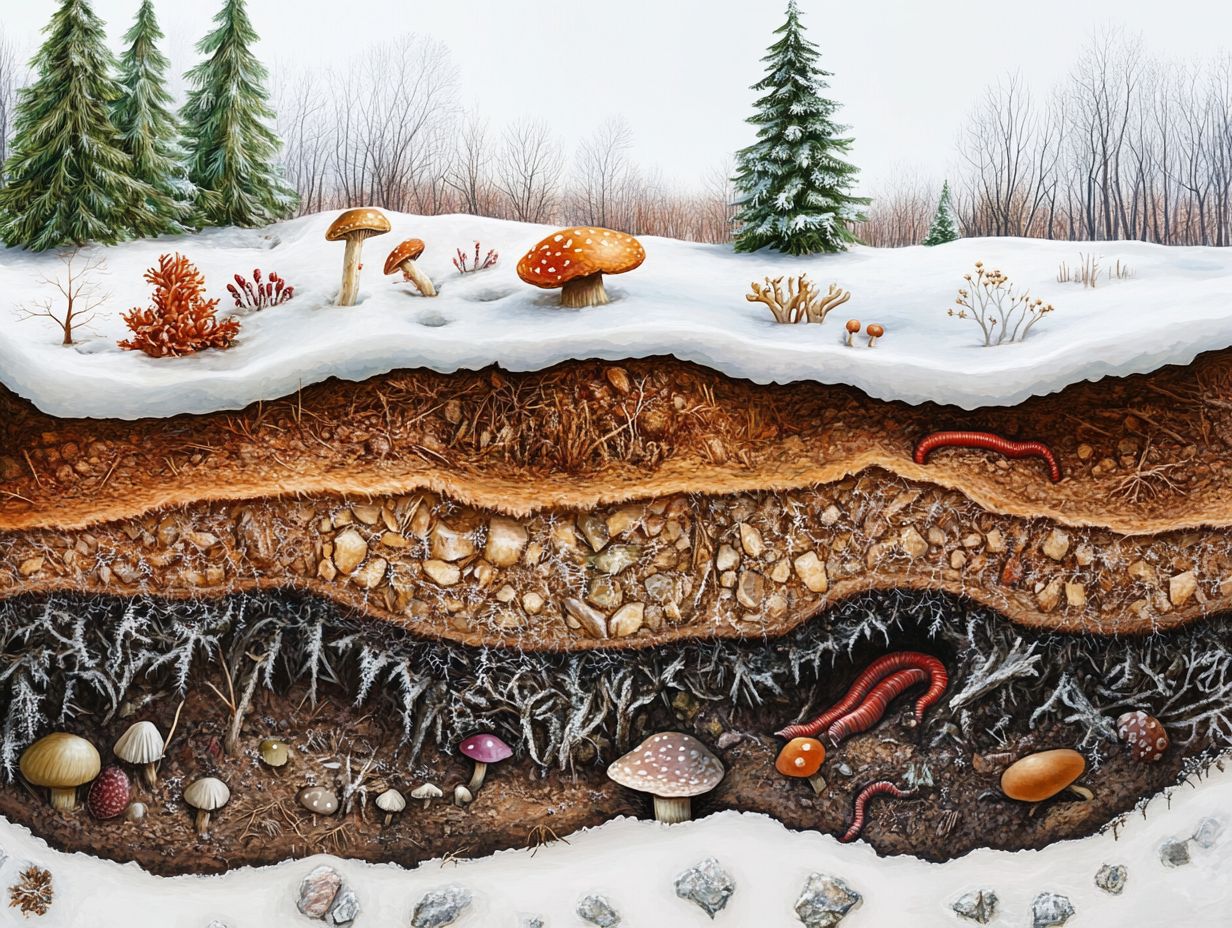
Techniques for enhancing soil health include applying organic amendments, boosting organic matter content, and implementing sustainable practices that nurture the Soil Food Web, contributing to the overall soil ecosystem.
By incorporating methods such as composting, you can enrich your soil with nutrient-dense organic matter. This creates an environment where microorganisms can thrive. Similarly, mulching is essential for moisture retention and temperature regulation. It forms a protective layer that welcomes beneficial insects and provides food sources for the Soil Food Web, enhancing weed suppression.
Using organic fertilizers not only supplies essential nutrients but also improves soil structure. This fosters healthier root development and increases biodiversity. Together, these practices significantly bolster the resilience of ecosystems, promoting a vibrant community of bacteria, fungi, and other organisms crucial for organic farming.
Choosing Cold-Adapted Plants
Choosing cold-adapted plants is essential to maximize agricultural productivity in cold climates while preserving soil health and supporting the Soil Food Web. This includes considering plant health and their role in nitrogen cycling.
These resilient plant varieties not only endure low temperatures but also foster biodiversity within your ecosystem. By selecting the right species, you can enhance nutrient cycling; these hardy plants contribute organic matter back to the soil, improving its structure and fertility.
Cold-tolerant crops can also provide habitat for beneficial microorganisms like mycorrhizal fungi, which play a crucial role in breaking down organic materials. This symbiotic relationship between plants and soil organisms cultivates a healthier environment, reducing reliance on chemical fertilizers and enhancing sustainability in your farming practices.
Start enhancing your soil today! Use these proven methods to create a thriving ecosystem.
Benefits of a Healthy Soil Food Web in Cold Climates
A thriving Soil Food Web in cold climates offers a wealth of advantages. It boosts plant growth and crop resistance, reduces reliance on chemical fertilizers, and enhances overall agricultural yields.
Embracing this natural ecosystem can transform your farming experience, making it not only more sustainable but also more productive!
Improved Plant Growth and Resilience
Improved plant growth and resilience are direct outcomes of a thriving Soil Food Web. The interactions among microorganisms, fungi, and larger soil organisms create a dynamic environment that enhances nutrient availability.
Mutual relationships like those between mycorrhizal fungi (fungi that form beneficial relationships with plant roots) and plant roots facilitate the absorption of essential minerals, such as phosphorus and nitrogen, directly impacting growth. A diverse community of soil organisms, including soil arthropods and protozoa, ensures the breakdown of organic matter, enriching the soil with vital nutrients.
As these components thrive together, they bolster plant health and enhance resilience against pests, diseases, and environmental stress. This synergy contributes to a more sustainable ecosystem, transforming your garden into a flourishing haven that supports soil conservation.
Reduced Need for Chemical Fertilizers
A thriving Soil Food Web minimizes reliance on chemical fertilizers by encouraging natural nutrient cycling and enhancing soil health through organic farming practices and soil management.
This transition nurtures biodiversity among microorganisms and ensures that crops receive essential soil nutrients more balanced. By cutting back on synthetic inputs, you contribute to environmental sustainability, significantly reducing the risk of waterway contamination.
Healthier soil translates to improved agricultural productivity, often resulting in higher yields over time while also supporting soil erosion prevention.
Nurturing the Soil Food Web is crucial for fostering a more resilient ecosystem that benefits both producers and consumers while tackling climate challenges such as climate change and soil degradation, ensuring soil conservation.
Frequently Asked Questions
What is the Soil Food Web in Cold Climates?
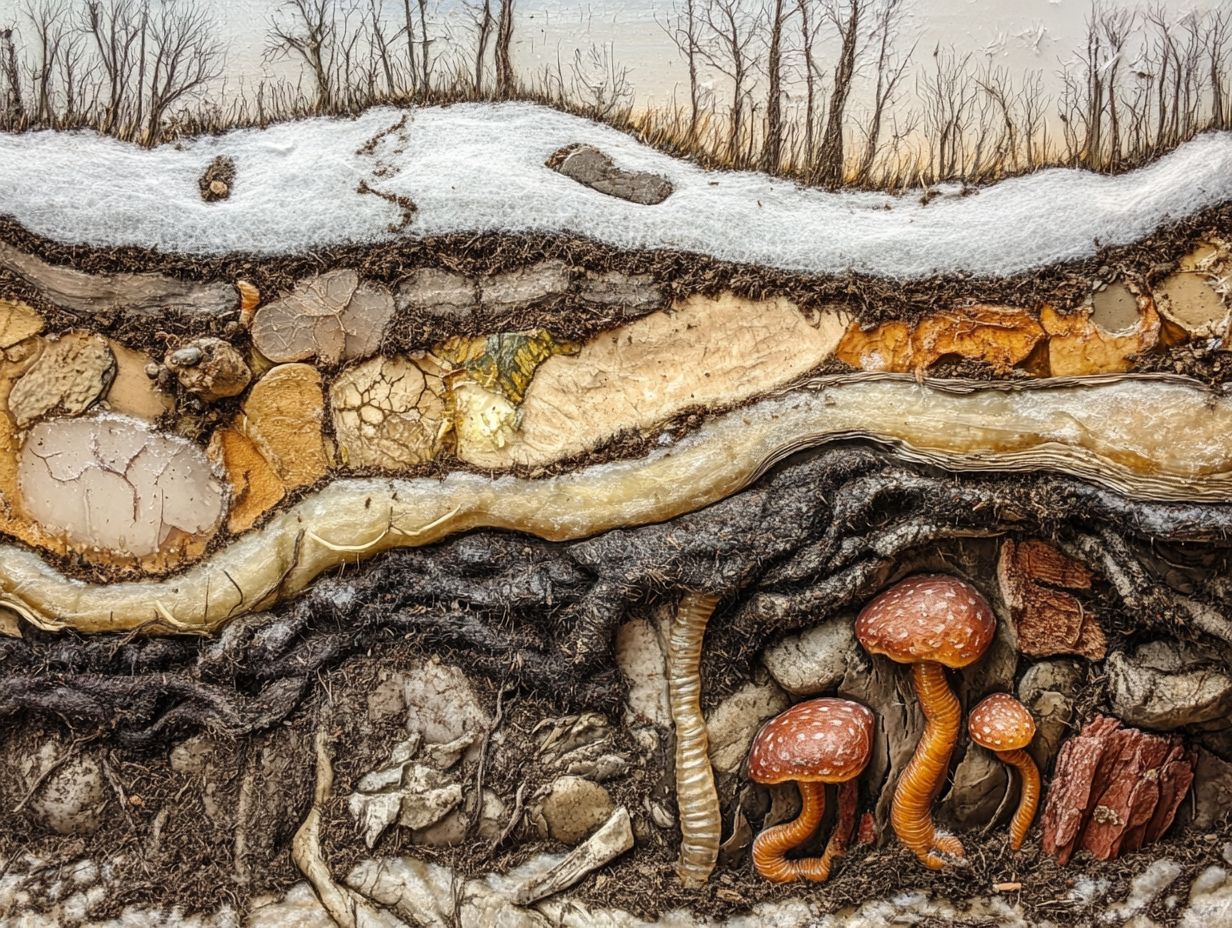
The Soil Food Web in cold climates refers to the complex ecosystem of organisms living in the soil, including bacteria, fungi, worms, and other microorganisms such as nematodes and soil arthropods. These organisms interact with each other and the environment to support plant growth and nutrient cycling.
Why is Understanding the Soil Food Web Important in Cold Climates?
Understanding the Soil Food Web is vital in cold climates because it affects the health and productivity of plants in these regions. For more insights, learn what to know about soil fertility in cold climates. The interactions between organisms in the soil can influence plant growth, nutrient availability, and soil quality, which are crucial for successful organic agriculture and gardening in colder environments.
What Challenges Does the Soil Food Web Face in Cold Climates?
Cold climates present unique challenges for the Soil Food Web, including colder temperatures, shorter growing seasons, and limited microbial activity. These factors can affect the diversity and activity of soil organisms, including small mammals, impacting nutrient cycling and plant growth.
How Can I Improve the Soil Food Web in My Cold Climate Garden?
There are several ways to improve the Soil Food Web in a cold climate garden, such as adding organic matter, using cover crops, and avoiding the use of chemical inputs and pesticides. These practices can increase the diversity and activity of soil microorganisms, leading to healthier plants and a more resilient ecosystem.
Start nurturing your soil food web today for a more resilient garden!
What role do plants play in the soil food web of cold climates?
Plants are essential in cold climates. They provide food and shelter for tiny soil organisms and insects.
They also help nutrients move through the soil, thanks to their roots and the organic matter they add. In return, soil organisms help plants absorb important nutrients and protect them from pests and diseases.
Can I still have a thriving soil food web in my cold climate if I use synthetic fertilizers and pesticides?
Synthetic fertilizers and pesticides might seem helpful, but they can damage the soil food web over time. These chemicals can kill helpful microorganisms and upset the ecosystem’s balance.
You can absolutely create a vibrant soil food web in your cold climate garden without relying on synthetic chemicals!




